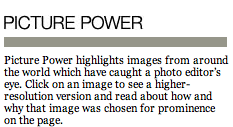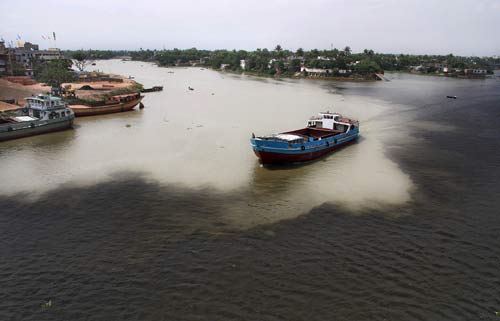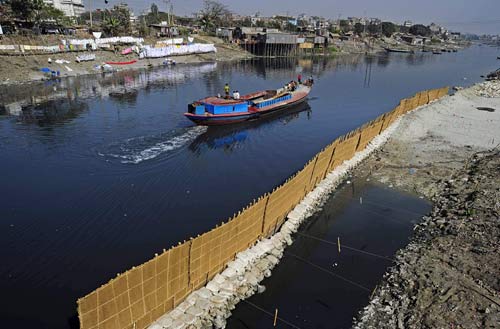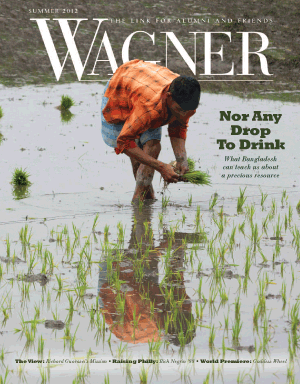

For almost 20 years, Professor Mohammad Alauddin has been working to solve the drinking water contamination problem in one of the world?s most populous and water-rich nations. What is the solution for Bangladesh ? and what can we learn from it? Insights from this year?s trip to Bangladesh through the Wagner Expanding Your Horizons program.
Story by Laura Barlament / Photos by Habibul Haque/Drik Continue reading “Water water everywhere, Nor any drop to drink”
Tag: Water
Win for Jashim Salam
Jashim Salam wins Honourable Mention at FCCT Photo Contest:
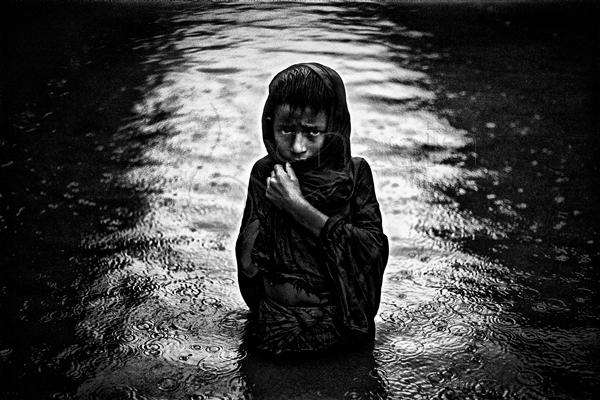
Jashim Salam is a Chittagong, Bangladesh-based photographer working for DrikNEWS, an international news photo agency, since 2008. He is also studying photojournalism in The South Asian Media Academy and Institute of Photography. His work focuses on social documentary such as profiles of migrant workers, handicapped people, and climate-change refugees. His work has been published in The Sunday Times Magazine, Reader’s Digest, Better Photography, CNN, Photojournale, National Geographic online, Reuters, and many others. He is the recipient of many awards including the Jury Special Award in the 6th Humanity Photo Awards.
Picture Power
Subscribe to ShahidulNews
World Press Photo Enter Magazine |
||||||||||||
|
||||||||||||
|
||||||||||||
River and Life
Subscribe to ShahidulNews
![]()
They meander and glide. They unfurl with the rage of monsoon fury. Quietly they flow in the misty winter morn. Rivers thread the fabric of our land. Embroider patches of fertile delta. They are the nakshi kantha of our rural folklore. Life giver, destroyer, enchanter, they have inspired the greatest myths, formed the tapestry for the most endearing love songs. Our Bhatiali has been shaped by the lilt of the boatman?s lyrics drifting across the waves.
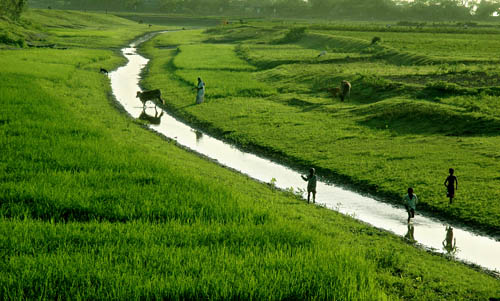
It is this fluid, amorphous, ephemeral and elusive visual that Kabir tries to hold in his rectangular frame. It is a frame heavy with the burden of its task. The rivers that float like a gossamer across the green delta hold untold stories. Tales of strife and endurance. Of the fullness of life. Of abundance ebbed, and anger unleashed.
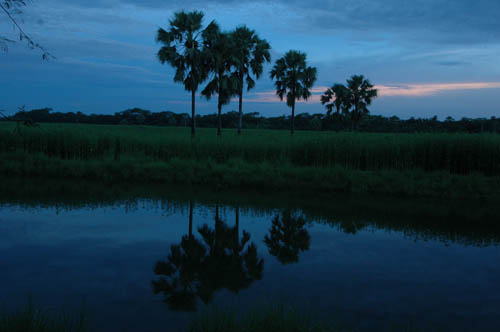
Kabir finds the rapidly disappearing sailboat drifting in the late afternoon light. The extinction of this species owes not to the depletion of its habitat, or to the oft-blamed climate change, but the advent of technology. Oil guzzling, deep tube well engines have unseated the wind from its traditional role.? A lone sail, bright red and taut against a blue sky defiantly throws a gauntlet to the mechanized usurper.

Swirling swathes of jute cleanse themselves in the very water that nurtured them in their youth. Wispy traces of boatmen recede into the darkness of dusk. The cool blue light of the evening sky wraps itself round a homebound farmer. Barefoot women, walk home after a day?s work, like a string of pearls along the sandy shores of a receding river. Parched river beds, like a desert amidst the oasis, make horizon-less paths for weary travelers to tread.
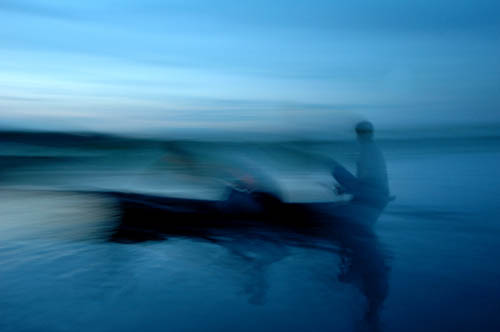
Fishermen, silhouetted against a brooding sky, cast their nets more in hope than in expectation. Overfishing of uncared for rivers, bloated with toxic waste, yield little to those who have made the river their home. Indeed it is their ancestral home. A liquid home that knew no government deeds, and obeyed no official maps. But the rules have changed. City folk whose feet walk only on the cool marble of urban dwellings own fishing rights to rivers they may never have seen. The fishermen who were raised in these waters are now outlawed in their own turf.
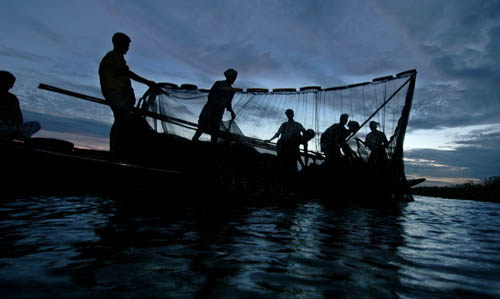
Still the river gives. Joy and thrill to the racing crews that steer swiftly through the monsoon breeze. Respite to the sun baked skin of naked boys, sari clad maidens and heavy hoofed buffalos. Turgidity to the parched leaves of the newly planted grains of rice. Looming clouds in azure skies to the poet who longs for whispering words. Winding arcs of sinewy lines to the painter?s canvas in search of form.
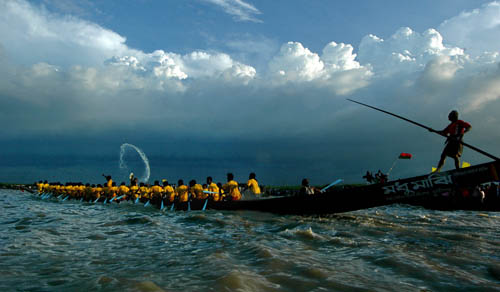
The great rivers, once bountiful and brimming, have formed the supple spine of our deltaic plains. Choking in silt, poisoned by waste, waterways throttled by land grabbing encroachers, the lifeblood of our deltaic plains weep dry tears as their once glistening bodies writhe in pain. It is a pain city dwellers are deaf to. A pain that short sighted politicians and profit seeking urban planners have no time for. Kabir rejoices in the vigour of the river. Is saddened by its pain. His portrait of the river shows both its wrinkles and its smile.
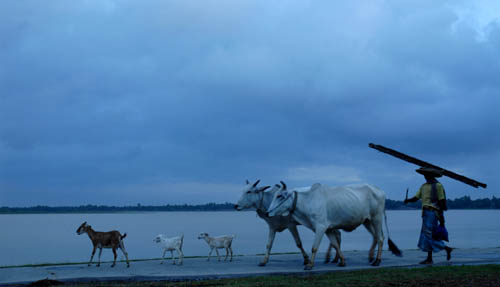
Photographs: Kabir Hossain
Text: Shahidul Alam
The exhibition “River and Life” by Kabir Hossain will remain open until the 17th July at the Drik Gallery II from 3:00 pm till 8:00 pm
Salt Water Tears
 photography by Munem Wasif text by Francis Hodgson plus an exclusive?audio interview about this project, plus?another short interviewabout his evolving style as a photographer. Every ecosystem has its fragile balance. That much we have already learnt. Scientists routinely now seek to document the excesses that will lead to imbalance, even where they can do nothing about them. And sometimes, just sometimes, legislation and implementation and eventually protection may follow. In the far south-west of Bangladesh, Munem Wasif shows us just what these abstract-sounding paradigms mean in practice. Nobody knows certainly why the water levels are changing in the Bay of Bengal, but they are. In a famously low-lying country, more and more people are under threat of catastrophic flooding. Coastal erosion, too, is accelerating, a matter of grave concern in a country where (under the pressure of population) every inch of usable land is at a premium. Munem Wasif found a region where changes to a single measurable fact ? salinity levels in the water table ? can be seen to have affected every part of the matrix of balances. Salinity has risen. The old agriculture is no longer possible because the old plants simply can?t grow. Shrimping ? a new industry ? has grown up, largely for export, using fewer workers and threatening the livelihood of many others. Shrimping in turn exposes more land to salt or brackish water. Farmers are reduced to occasional labour. Established structures of work and the societies centred on work change and break down. Many people have to venture into the mangrove swamps of the Sundarbans (a national park on the Indian side of the border, but not yet on the Bangladeshi) to fish or to collect roofing materials which used to be available closer to hand. In the Sundarbans they are exposed to a terrifying catalogue of risk, including attack from dog sharks, crocodiles, king cobras and the Bengal tiger. Women (it?s always the women) have to go ever farther in search of fresh water. New diseases become frequent, obviously connected to all these changes, but not yet provably so. So it goes on, a kaleidoscope of interconnected shifts, not fully understood, and not half predictable with accuracy. Munem Wasif has not gone to this blighted region to show us the abstractions of climate-change experts or the theories of macro-economists. Photography deals in the particular, and this project deals in the very particular. Wasif is himself Bangladeshi. Not for him the flak-jacket, the adrenaline rush, and five hours in the red zone. These are his people, although not quite in his part of the country. The accent is different but the language is shared. Wasif in fact rented a motorcycle to complete this commission, and when he tells you the names of the people in the pictures it?s because he met them and heard them, and knew them a little. The pictures, then, are almost by definition subjective. Too much ink has been spilt trying to work out when and whether photographers tell the truth. These pictures are absolutely personal to Wasif, absolutely his expression of his sentiments. But that doesn?t stop them being also a remarkable ? and true ? document of what is happening in the interplay of some of the complex of variables in this corner of Bangladesh. Photography reads big and small. Wasif shows you Johura Begum?s long arm reaching out to her husband as he dies of cancer of the liver, that simple tenderness is the only available healthcare in a village whose population are in desperate need. It?s a little tiny truth, certainly. The husband died, the woman lived on, widowed. The photographer was there, he knows. But it is also and at the same time a complex of many metaphors. There are many pictures like this because this scene has been played out so many times all over the world. It?s a picture ?about? infrastructure and financing, too, as well as morality and ethics. In another searing picture, containers of fresh water are dragged on foot in boats through clinging sterile mud. Shajhan Shiraj and his brothers from Gabura, we?re told, travel three hours in this kind of way every day. Stunted trees, clear water only in the distance, three men, three boats, and the keel-trail they etch in the mud. It?s not just a beautiful picture: the irony of boats travelling so painfully slowly by land with water as their only cargo is unimaginably painful. There is a powerful crossover in the way pictures work. Read these pictures only as little truths and they will wrench out your heart. Read them as big truths and they will drive you towards planning practical effort for change. you don?t need to know that Johura Begum?s husband was called Amer Chan to be moved to action by Wasif. We read about donor fatigue, compassion fatigue. Every viewer of these pictures will have at some point the sense of having seen them before. Salgado in the Sahel, just as shocking, maybe more. Very similar in feel and tonality. But it is not up to the photographers to provide us with new scenes. As long as those scenes are there and look the way they do, photographers will continue to show them to us. Some people will look at Wasif?s pictures here and call them derivative, and they?ll be right. But it isn?t fashion. There is not going to be a new length of trousers this season in the liver cancer business. Photographers can only do so much. If viewers are tired of being harrowed, tired of seeing these scenes one shouldn?t have to look at, perhaps we can understand that it?s the viewers who need to perk up their ideas, not the photographers. Munem Wasif, for one, is doing his bit. Now it?s up to us. ? Francis Hodgson Head of Photographs, Sotheby’s Chairman of Judges, Prix Pictet from the essay Munem Wasif: Tiny Truths, Big Truths Munem Wasif was shortlisted for the?Prix Pictet in 2008. As an integral element of the prize, Pictet decided to commission one of the shortlisted artists to record a water-related project. These photographs are the result. |
What Matters
Subscribe to ShahidulNews
The World’s Preeminent Photojournalists and Thinkers Depict Essential Issues of Our Time
Sterling. 2008. 335p. ed. by David Elliot Cohen. photogs. index. ISBN 978-1-4027-5834-8. $27.95. POL SCI
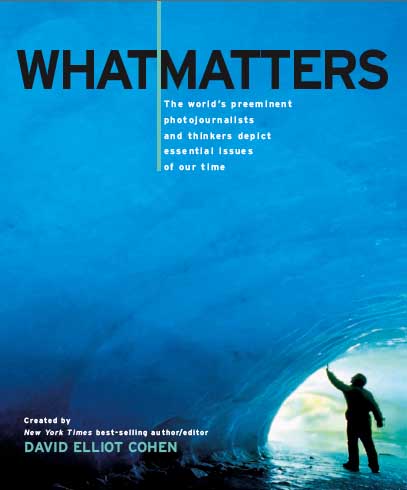
PHOTOGRAPHY EXPOSES TRUTHS, advances the public discourse, and demands action. In What Matters, eighteen important stories by today?s preeminent photojournalists and thinkers poignantly address the big issues of our time?global warming, environmental degradation, AIDS, malaria, the global jihad, genocide in
Darfur, the inequitable distribution of global wealth and others. A “What You Can Do” section offers 193 ways to learn more and get involved.
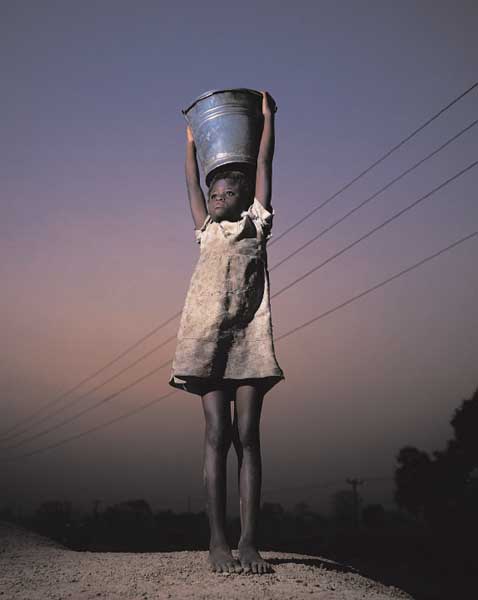
Photographed by:
Shahidul Alam ? The Associated Press ? Gary Braasch ? Marcus Bleasdale ? Raymond Depardon ? Paul Fusco ? Lauren Greenfield ? Maggie Hallahan ? Ed Kashi ? Gerd Ludwig ? Magnum ? Susan Meiselas ? James Nachtwey ? Shehzad Noorani ? Gilles Peress ? Sebasti?o Salgado ? Stephanie Sinclair ? Brent Stirton ? Tom Stoddart ? Anthony Suau ? Stephen Voss
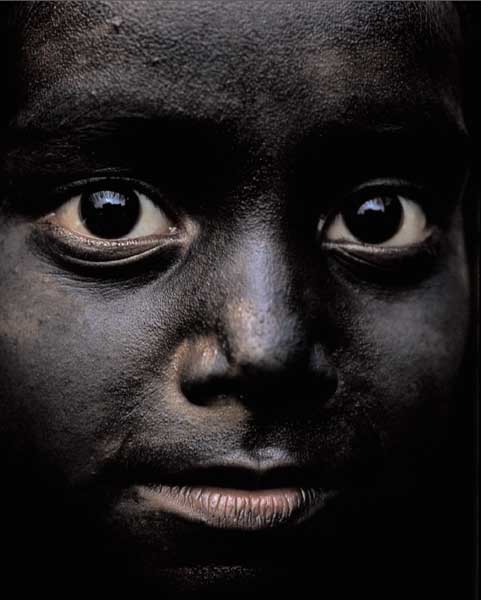
Commentary by:
Omer Bartov ? Judith Bruce ? Awa Marie Coll-Seck ? Richard Covington ? Elizabeth C. Economy ? Helen Epstein ? Fawaz A. Gerges ? Peter H. Gleick ? Gary Kamiya ? Paul Knox ? David R. Marples ? Douglas S. Massey ? Bill McKibben ? Samantha Power ? John Prendergast ? Jeffrey D. Sachs ? Juliet B. Schor ?
Michael Watts
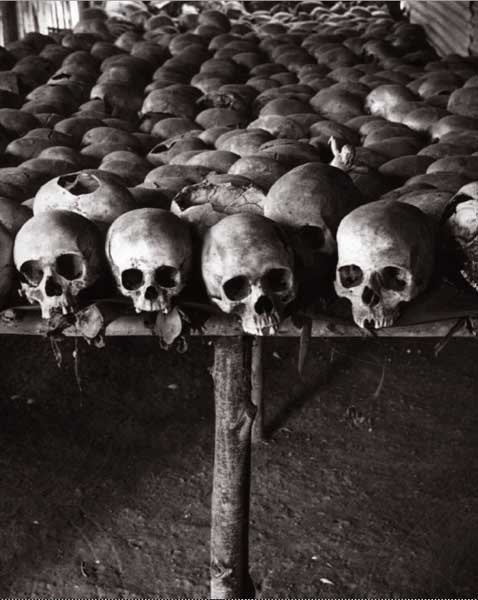
What Matters?an audacious undertaking by best-selling editor and author David Elliot Cohen?challenges us to consider how socially conscious photography can spark public discourse, spur reform, and shift the way we think. For 150 years, photographs have not only documented human events, but also changed their course?from Jacob Riis?s expos? of brutal New York tenements to Lewis Hine?s child labor investigations to snapshots of torture at Abu Ghraib prison. In this vein, What Matters presents eighteen powerful stories by this generation?s foremost photojournalists. These stories cover essential issues confronting us and our planet: from climate change and environmental degradation to global jihad, AIDS, and genocide in Darfur to the consequences of the Iraq war, oil addiction, and the inequitable distribution of global wealth. The pictures in What Matters are personal and specific, but still convey universal concepts. These images are rendered even more compelling by trenchant commentary. Cohen asked the foremost writers, thinkers, and experts in their fields to elucidate issues raised by the photographs.
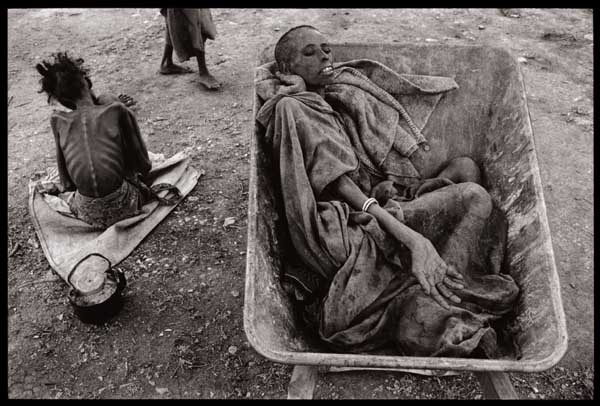
Some stories in What Matters will make you cry; others will make you angry; and that is the intent. What Matters is meant to inspire action. And to facilitate that action, the book includes an extensive ?What You Can Do? section??a menu of resources, web links, and effective actions you can take now.
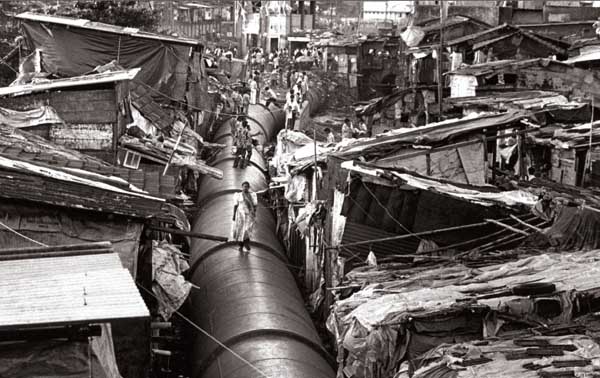
Cohen hopes What Matters will move people to take positive steps??no matter how small??that will help change the world. As he says in his introduction, the contributors? work is so compelling that ?if we show it to you, you will react with outrage and create an uproar.? If, says Cohen, you look at these stories and think, ?What?s the use? The world is irredeemably screwed up,? we should remember that, historically, outraged citizens have gotten results. ?We did actually abolish slavery and child labor in the US; we abolished apartheid in South Africa; we defeated the Nazis; we pulled out of Vietnam. As the saying goes, ?All great social change seems impossible until it is inevitable.? ?
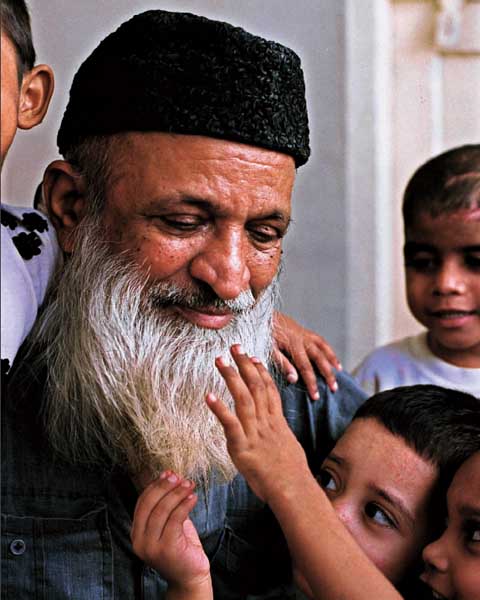
– Michael Zajakowski, Chicago Tribune
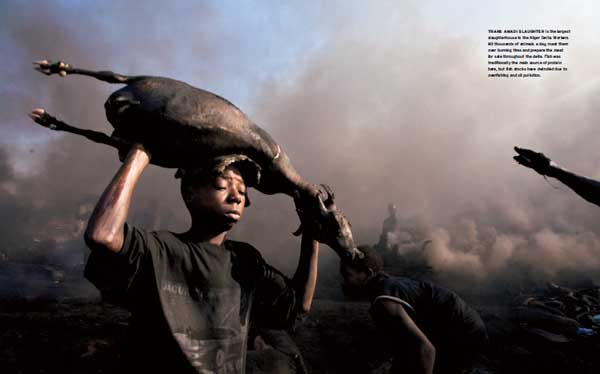
A. Newspapers and Online
1. Hard to see, impossible to turn away – Issues and images combine in ‘What Matters,’ a powerful and passionate new book
“Great documentary photojournalism, squeezed out of mainstream newspapers and magazines in an age of shrinking column inches, has had a hard time gaining traction in other venues… But nobody has told the 18 photographers in “What Matters: The World’s Preeminent Photojournalists and Thinkers Depict Essential Issues of Our Time.” These are photo essays by some of today’s best photojournalists following the great tradition begun over a hundred years ago with the expos?s of New York tenement life by Jacob Riis. Through the doggedness of these photographers?who are clearly committed to stirring us out of complacency?all the power and passion of the medium is evident in this book… Some of the pieces will break your heart, some will anger you. All will make you think. To channel your thoughts and feelings into action, the book ends with an appendix “What You Can Do,” offering hundreds of ways to be a part of the solution to these problems.”
– Chicago Tribune Book Review, 2 page spread
2. “Must viewing.”
– San Francisco Chronicle, 2 page story
3. Photographs that Can Change the World
“David Elliot Cohen?s new book, What Matters, which hits bookshelves today, is a collection of photo essays that explore 18 distinct social issues that define our time. Shot by the world?s most renowned photojournalists, including James Nachtwey, who has contributed to V.F., the photographs explore topics ranging from genocide and global warming to oil addiction and consumerism, offering a raw view into the problems that plague our world. Each photo essay is accompanied by written commentary from an expert on the issue. Cohen hopes the book will inspire people to work toward resolving these problems. ?Great photojournalism changed the world in the past, and it can do it again,? Cohen says. ?I want people to see these images, get angry, and act on that anger. Compelling images by the world?s best photojournalists is the most persuasive language I have to achieve this.?
– vanityfair.com
4. Book Review: What Matters
“Changing the world might sound like a lofty goal for a photo book, but that?s what the new book, What Matters, The World?s Preeminent Photojournalists and Thinkers Depict Essential Issues of our Time edited by David Elliot Cohen (Sterling Publishing, $28, 2008), hopes to do. Citing the power of socially conscious photographers over the last 150 years, the beautiful collection of 18 photo-essays by some of today?s prominent photojournalists hopes to ?inform pre-election debate and inspire direct action.” Regardless of what side of the political fence you sit on, this collection of heartbreaking and powerful stories and images is guaranteed to get you thinking.”
– Popular Photography
5. What Matters: The World’s Preeminent Photojournalists and Thinkers Depict Essential Issues of Our Time.
Those doubting the power of photojournalism to sway opinion and encourage action would do well to spend some time with this book. In 18 stories, each made up of photos by leading photojournalists and elucidated by short essays by public intellectuals and journalists, this book explores environmental devastation, war, disease, and the ravages of both poverty and great wealth. The photos are specific and personal in their subject matter and demonstrate how great photography can illuminate the universal by depicting the specific. Cohen has a goal beyond simply showcasing terrific photography. In his thoughtful introduction, he makes explicit his aim to connect the work compiled here with the great tradition of muckraking photography that helped to change conditions in New York tenements and to end child labor at the turn of the last century. A terrific concluding chapter directs readers to specific actions they can take if they are moved to do so by the book’s images, and it’s hard to imagine the reader who would not be moved. Highly recommended for public libraries and academic libraries supporting journalism and/or photography curricula. (a starred review in Library Journal generally means the book will be acquired by many libraries.)
– Library Journal
6. First of five part series about What Matters
(The first installment drew 500,000 page views)
– CNN.com
7. Second part in CNN. Black Dust by Shehzad Noorani
The First Element
Subscribe to ShahidulNews
![]()
Poem on Waterwall at exhibition “The First Element” at the National Art Gallery Malaysia.
Water
Fluid, flowing, feeling, water
Life, death, birth, union, water
Meandering, shaping, eroding, changing, water
Cosmos, clouds of gas, the ice age, frozen seas, water
Drips
Waving, trickling, surging, swaying, water
Giving, creating, forming, bleeding, water
Emotions, passion, unbridled, desire, water
Decanting, oozing, seeping, leaking, leeching, water
Drops
Wanting, longing, aching, waiting, water
Spraying, spurting, frothing, spewing, water
Coalescing, merging, blending, easing, water
Searching, probing, seeking, beseeching, water
Damp
Dank, fog, mist, wistful water
Soaked in tears
Bathed in rain
Drenched in joy
Cleansed in pain
Immersed in womb
The first element
Water
Shahidul Alam
Mon Nov 10, 2003
Brahmaputra Diary
Subscribe to ShahidulNews
Multimedia version with video and photographs
A gentle trickle
A surging river
A gentle plain
A delta
Four long years
Three thousand kilometres
Cormorants, sea gulls
Sparrows at dusk
A flurry of wings
Moody clouds
La brume matinale
Boats bathed in twilight red
Wild blossoms
In narrow paths
A banyan tree
Tall strong shady
A forlorn reed
In amber garb
Bamboo groves
Reaching for the sky
Arching along the water
Coconut palms
Betwixt the land and the sea
A river rests, a delta speaks
Older than the mountains, it is a river that forces its way across the towering Himalayas. The Tibetans know it as the Yarlung Tsang Po (the purifier). In India it is known as the Brahmaputra. In Bangladesh it is also known as the Jamuna, the Padma and finally the Meghna before it opens into the sea. No one is known to have traversed the entire run of the river. We take you on this journey, across the millenium, across three nations, through Buddhism, Hinduism and Islam. From the icy trickle in the glaciers. Along Pei in China, where the river narrows into a rapid-filled gorge reaching phenomenal depths and amazing cascades. Through the crystal clear waters in Arunachal Pradesh. Across the We take you sailing along the Brahmaputra.
The Brahmaputra Diary. An exhibition based on my journey along this majestic Asian river opens at the Sutra Gallery in Kuala Lumpur tonight (Sunday the 7th September) at 8:00 pm.
Shahidul Alam
Sun Sep 7, 2003
Multimedia version with video in Zonezero.com



